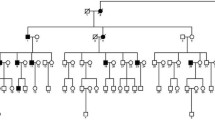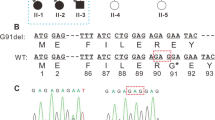Summary
Congenital cataract is a highly heterogeneous disorder at both the genetic and the clinical-phenotypic levels. A unique cataract was observed in a 4-generation Chinese family, which was characterized by autosomal dominant inheritance and late-onset. Mutations in the 13 known genes (CRYAA, CRYAB, CRYBB1, CRYBB2, CRYGC, CRYBA1/A3, CRYGD, Connexin50, Connexin46, intrinsic membrane protein LIM2, cytoskeletal protein BFSP2, the major intrinsic protein-MIP and the heat shock factor HSF4) have previously been demonstrated to be the frequent reason for isolated congenital cataracts, but the exact molecular basis and underlying mechanisms of congenital cataract still remain unclear. This study was designed to find whether these 13 genes developed any mutation in the family members and to identify the disease-causing gene. Polymerase chain reaction (PCR) and direct DNA sequence analysis were carried out to detect the 13 genes. The results showed that no mutation causing amino acid alternations was found in these potential candidate genes among all patients in the family, and only several single-nucleotide polymorphisms (SNPs) were identified. A transitional mutation in the fourth intron of CRYBB2 and some silent mutations in the first exon of BFSP2 and CRYGD were found in the cataract family, but further study showed that these mutations could also be found in normal controls. It was concluded that some unidentified genes may underlie the occurrence of late-onset cataract in this family. A genome-wide screening will be carried out in the next study.
Similar content being viewed by others
References
Lim AS. Vision for the world. Eur J Ophthalmol, 1996,6(1):95
McCarty A, Taylor HR. The genetics of cataract. Invest Ophthalmol Vis Sci, 2001,42(8):1677–1678
Hejtmancik JF. The genetics of cataract: our vision becomes clearer (editorial). Am J Hum Genet, 1998,62(3):520–525
Delcourt C, Carriere I, Delage M, et al. Associations of cataract with antioxidant enzymes and other risk factors: the French Age-Related Eye Diseases (POLA) Prospective Study. Ophthalmology, 2003,110(12):2318–2326
Tsai SY, Hsu WM, Cheng CY, et al. Epidemiologic study of age-related cataracts among an elderly Chinese population in Shih-Pai, Taiwan. Ophthalmology, 2003,110(6):1089–1095
Hammond CJ, Duncan DD, Snieder H, et al. The heritability of age-related cortical cataract: the twin eye study. Invest Ophthalmol Vis Sci, 2001,42(3):601–605
Hammond CJ, Snieder H, Spector TD, et al. Genetic and environmental factors in age related nuclear cataracts in monozygotic and dizygotic twins. N Engl J Med, 2000,342(24):1786–1790
Pras E, Frydman M, Levy-Nissenbaum E, et al. A nonsense mutation (W9X) in CRYAA causes autosomal recessive cataract in an inbred Jewish Persian family. Invest Ophthalmol Vis Sci, 2000,41(11):3511–3515
Berry V, Francis P, Reddy MA, et al. Alpha-B crystalline gene (CRYAB) mutation causes dominant congenital posterior polar cataract in humans. Am J Hum Genet, 2001,69(5):1141–1145
Mackay DS, Boskovska OB, Knopf HL, et al. A nonsense mutation in CRYBB1 associated with autosomal dominant cataract linked to human chromosome 22q. Am J Hum Genet, 2002,71(5):1216–1221
Litt M, Carrero-Valenzuela R, LaMorticella DM, et al. Autosomal dominant cerulean cataract is associated with a chain termination mutation in the human beta-crystallin gene CRYBB2. Human Molecular Genetics, 1997,6(5):665–668
Bateman JB, Geyer DD, Flodman P, et al. A new betaA1-crystallin splice junction mutation in autosomal dominant cataract. Invest Ophthalmol Vis Sci, 2000,41(11):3278–3285
Heon E, Priston M, Schorderet DF, et al. The gamma-crystallins and human cataracts: a puzzle made clearer. Am J Hum Genet, 1999,65(5):1261–1267
Stephan DA, Gillanders E, Vanderveen D, et al. Progressive juvenile-onset punctuate cataracts caused by mutation of the γD-crystallin gene. Proc Natl Acad Sci USA, 1999,96(3):1008–1012
Berry V, Mackay D, Khaliq S, et al. Connexin50 mutation in a family with congenital “zonular nuclear” pulverulent cataract of Pakistani origin. Hum Genet, 1999,105(1–2):168–170
Polyakov AV, Shagina IA, Khlebnikova OV, et al. Mutation in the connexin 50 gene (GJA8) in a Russian family with zonular pulverulent cataract. Clin Genet, 2001,60(6):476–478
Pal JD, Liu X, Mackay D, et al. Connexin46 mutations linked to congenital cataract show loss of gap junction channel function. Am J Physiol Cell Physiol, 2000,279(3):C596–C602
Pras E, Levy-Nissenbaum E, Bakhan T, et al. A missense mutation in the LIM2 gene is associated with autosomal recessive presenile cataract in an inbred Iraqi Jewish family. Am J Hum Genet, 2002,70(5):1363–1367
Conley YP, Erturk D, Keverline A, et al. A juvenile-onset, progressive cataract locus on chromosome 3q21–q22 is associated with a missense mutation in the beaded filament structural protein-2. Am J Hum Genet, 2000,66(4):1426–1431
Berry V, Francis P, Kaushal S, et al. Missense mutations in MIP underlie autosomal dominant “polymorphic” and lamellar cataracts linked to 12q. Nat Genet, 2000,25(1):15–17
Bu L, Jin Y, Shi Y, et al. Mutant DNA-binding domain of HSF4 is associated with autosomal dominant lamellar and Marner cataract. Nat Genet, 2002,31(3):276–278
Antonarakis SE. Recommendations for a nomenclature system for human gene mutations. The nomenclature working group. Hum Mutat, 1998,11(1):1–3
Graw J, Loster J, Soewarto D, et al. Characterization of a mutation in the lens-specific MP70 encoding gene of the mouse leading to a dominant cataract. Exp Eye Res, 2001,73(6):867–876
Heon E, Paterson AD, Fraser M, et al. A progressive autosomal recessive cataract locus maps to chromosome 9q13–q22. Am J Hum Genet, 2001,68(3):772–777
Zhang S, Liu M, Dong JM, et al. Identification of a genetic locus for autosomal dominant infantile cataract on chromosome 20p12.1–p11.23 in a Chinese family. Mol Vis, 2008,14:1893–1899
Hejtmancik JF, Smaoui N. Molecular genetics of cataract. Dev Ophthalmol, 2003,37:67–82
Author information
Authors and Affiliations
Corresponding author
Additional information
Both authors contributed equally to this work.
This study was supported by a grant from the National Natural Sciences Foundation of China (No. 30700455).
Rights and permissions
About this article
Cite this article
Yang, G., Zhong, S., Zhang, X. et al. Molecular genetic analysis of autosomal dominant late-onset cataract in a Chinese Family. J. Huazhong Univ. Sci. Technol. [Med. Sci.] 30, 792–797 (2010). https://doi.org/10.1007/s11596-010-0660-9
Received:
Published:
Issue Date:
DOI: https://doi.org/10.1007/s11596-010-0660-9




